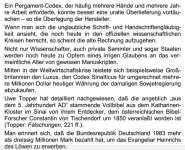Steven Avery
Administrator
Uwe Topper's book:
Fälschungen der Geschichte: von Persephone bis Newtons Zeitrechnung (2001)
https://books.google.com/books/about/F?lschungen_der_Geschichte.html?id=59M8AAAACAAJ
has a section on Sinaiticus, and he clearly did do some research. He is one of the few who really understood a lot before the 2009 CSP made the physical corroborating evidences available. His position basically asserts that Tischendorf actively helped setting up the production.
Uwe pointed out to me in an email the fact of the discovery being a larger size than is the current ms, a point that from Gregory that is referenced in Metzger and Aland (and is also in Wikipedia). And is generally passed over without notice. And when I checked into that more, it turned out that all the evidence is that Tischendorf actually chopped off notes! (A point missed in 150 years of Sinaiticus science.)
Are there other tidbits? Maybe someone with German skills can check the book, it would be much appreciated. The book has some pages on other uncials as well, Sinaiticus gets a full, moderately long chapter, almost 20 pages.
The "New Chronology" approach is rather unusual, and it is clear that Sinaiticus supplies them a soft target of false history, since the evidence is so clear that it was written in the 1800s. Thus the Uwe Topper study on Sinaiticus can be interesting even if his basic overall position is rejected. In general, it would also be interesting to see what he says about the group of uncials that have a provenance going back to the 1400s to 1600s, however our key concern is Sinaiticus.
It would also be interesting to know to what extent Uwe Topper uses the Morozov information.
Fälschungen der Geschichte: von Persephone bis Newtons Zeitrechnung (2001)
https://books.google.com/books/about/F?lschungen_der_Geschichte.html?id=59M8AAAACAAJ
has a section on Sinaiticus, and he clearly did do some research. He is one of the few who really understood a lot before the 2009 CSP made the physical corroborating evidences available. His position basically asserts that Tischendorf actively helped setting up the production.
Uwe pointed out to me in an email the fact of the discovery being a larger size than is the current ms, a point that from Gregory that is referenced in Metzger and Aland (and is also in Wikipedia). And is generally passed over without notice. And when I checked into that more, it turned out that all the evidence is that Tischendorf actually chopped off notes! (A point missed in 150 years of Sinaiticus science.)
Are there other tidbits? Maybe someone with German skills can check the book, it would be much appreciated. The book has some pages on other uncials as well, Sinaiticus gets a full, moderately long chapter, almost 20 pages.
The "New Chronology" approach is rather unusual, and it is clear that Sinaiticus supplies them a soft target of false history, since the evidence is so clear that it was written in the 1800s. Thus the Uwe Topper study on Sinaiticus can be interesting even if his basic overall position is rejected. In general, it would also be interesting to see what he says about the group of uncials that have a provenance going back to the 1400s to 1600s, however our key concern is Sinaiticus.
It would also be interesting to know to what extent Uwe Topper uses the Morozov information.
Last edited:



